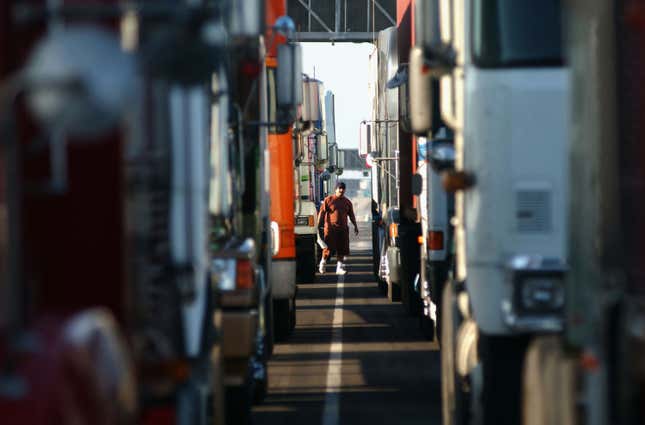The trucking industry is in turmoil. In the last few years, crisis after crisis has revealed our logistics blindside, and it’s usually related to an urgent need for truckers. Folks have tried to fix the shortage by suggesting we lower driver age restraints or that we hire truckers from overseas — as if the rest of the world wasn’t in need of truckers. A new study claims that more truckers now will cause another problem later, because it won’t be long before 500,000 truckers lose their jobs to robots.
The robot truckers are coming, for better or worse, so move over Erik Estrada. Robots could drive big rigs sooner than we expect and retire the job title of long-haul trucker. It’s not like the industry will become fully automated. Robot truckers will handle the long, tedious portions of cargo transport while human truckers handle the beginning and end of deliveries. The study calls this the “transfer hub model,” and Bloomberg describes it as follows:
The short trip from a factory or distribution center to an interstate is usually far more complicated than the next several hundred miles. The same is true once the machine exits the interstate. One solution is for trucking companies to set up transfer stations at either end, where human drivers handle the tricky first leg of the trip and then hitch their cargo up to robot rigs for the tiresome middle portion. Another station at the exit would flip the freight back to an analog truck for delivery.
The authors of the study were surprised that truckers agree about the viability of automating long sections of deliveries. And it’s not just truckers. Tech startups, such as TuSimple and Aurora, claim self-driving trucks are close to being commercially viable for long-haul deliveries.

Right now, the problem is dealing with bad weather, which the robot truckers aren’t good at. This has limited a lot of autonomous truck testing to America’s Sun Belt. Bloomberg estimates that in this region alone, robot truckers could do about 10 percent of all long-haul driving. Or if robots drive trucks nationwide on warmer months only, that would account for 50 percent of long-haul driving.
In terms of work reduction for people, that’s still somewhere between 50- and 250,000 jobs lost to robots. The authors of the study warn policymakers to consider the impact these robot truckers will have on truckers. But what’s most fascinating is that the authors say the same “transfer hub model” is already prevalent even without robot truckers. From Bloomberg:
“It is happening already, but in a fairly limited way,” said Parth Vaishnav, a climate and energy assistant professor at Michigan and co-author of the study. There are about 3.3 million truck drivers in America, though many don’t stay in the trade long. The long-haul jobs, in particular, are some of the worst. Not only are they protracted and tedious, but they are among the lowest-paid gigs. Long-haul drivers are on the road about 300 days a year and make around $47,000; short-haul routes can be trickier and, as such, pay better and attract more experienced drivers.
Not surprisingly, the long-haul workforce tends to turn over entirely every 12 months or so. At the moment, the industry is short about 61,000 drivers, according to the American Trucking Associations. “In our imagination, we see these as middle-class jobs,” Vaishnav said, “but that hasn’t been the case for awhile now.”
We already have human robot truckers! These drivers work like machines but still don’t make much money. Overworked and underpaid. Is it any wonder there’s a trucker shortage? Really, we are left to wonder whether the hundreds of thousands of jobs that may be lost to robot truckers are losses at all.
